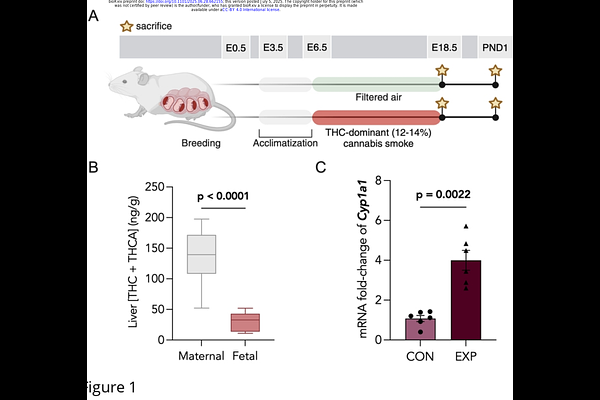Prenatal cannabis smoke exposure alters placental development in a murine model of pregnancy

Prenatal cannabis smoke exposure alters placental development in a murine model of pregnancy
Podinic, T.; Sunil, M.; MacAndrew, A.; Monaco, C.; Lee, G.; Lockington, C.; Lucas, A.-M.; Tomy, T.; Kasinska, J.; Jamshed, L.; Holloway, A.; Petrik, J.; Tomy, G.; Ratcliffe, E.; Raha, S.
AbstractCannabis use during pregnancy continues to increase with smoking remaining the most common mode of consumption. While clinical studies highlight an association between prenatal cannabis use and adverse pregnancy outcomes, less is known about placental outcomes, even though many of the reported pregnancy outcomes are thought to be mediated via placental dysfunction. Here, we established a mouse model of gestational cannabis smoke exposure to investigate the impacts on fetal outcomes and placental structure and function. Pregnant CD1 mice were exposed daily to {Delta}9-tetrahydrocannabinol (THC)-dominant cannabis smoke (12-14% THC, 0-2% CBD) or filtered air from embryonic day (E)6.5 to E18.5 or parturition. Cannabinoid analyses in cannabis smoke-exposed, paired maternal and fetal livers revealed total THC and 11-Nor-9-carboxy-THC (THCA) concentrations of 135.95 {+/-} 13.60 ng/g and 30.84 {+/-} 4.68 ng/g, respectively. Moreover, Cyp1a1, a smoke-inducible enzyme, was induced by 4-fold in cannabis smoke-exposed placentae. No changes in offspring body weights were observed; however, there was a marked decrease in the brain-to-body weight ratio of exposed postnatal day 1 (PND1) offspring. Placentae from exposed dams were significantly reduced in size, with altered zonation marked by a significantly decreased junctional zone and increased labyrinth zone. Key trophoblast differentiation markers (Tfap2c, Tpbpa, Pcdh12) and placental endocrine regulators (Pl2, Igf1r) were significantly downregulated following cannabis smoke exposure in placentas. Furthermore, transcript levels of placental nutrient and vascularization markers, Glut1, Vegfa and Pparg were significantly decreased in cannabis smoke-exposed placentas. By employing a physiologically relevant platform of prenatal cannabis exposure in vivo we demonstrate the adverse effects of prenatal cannabis smoke exposure on placental structure and function as well as on fetal brain growth.